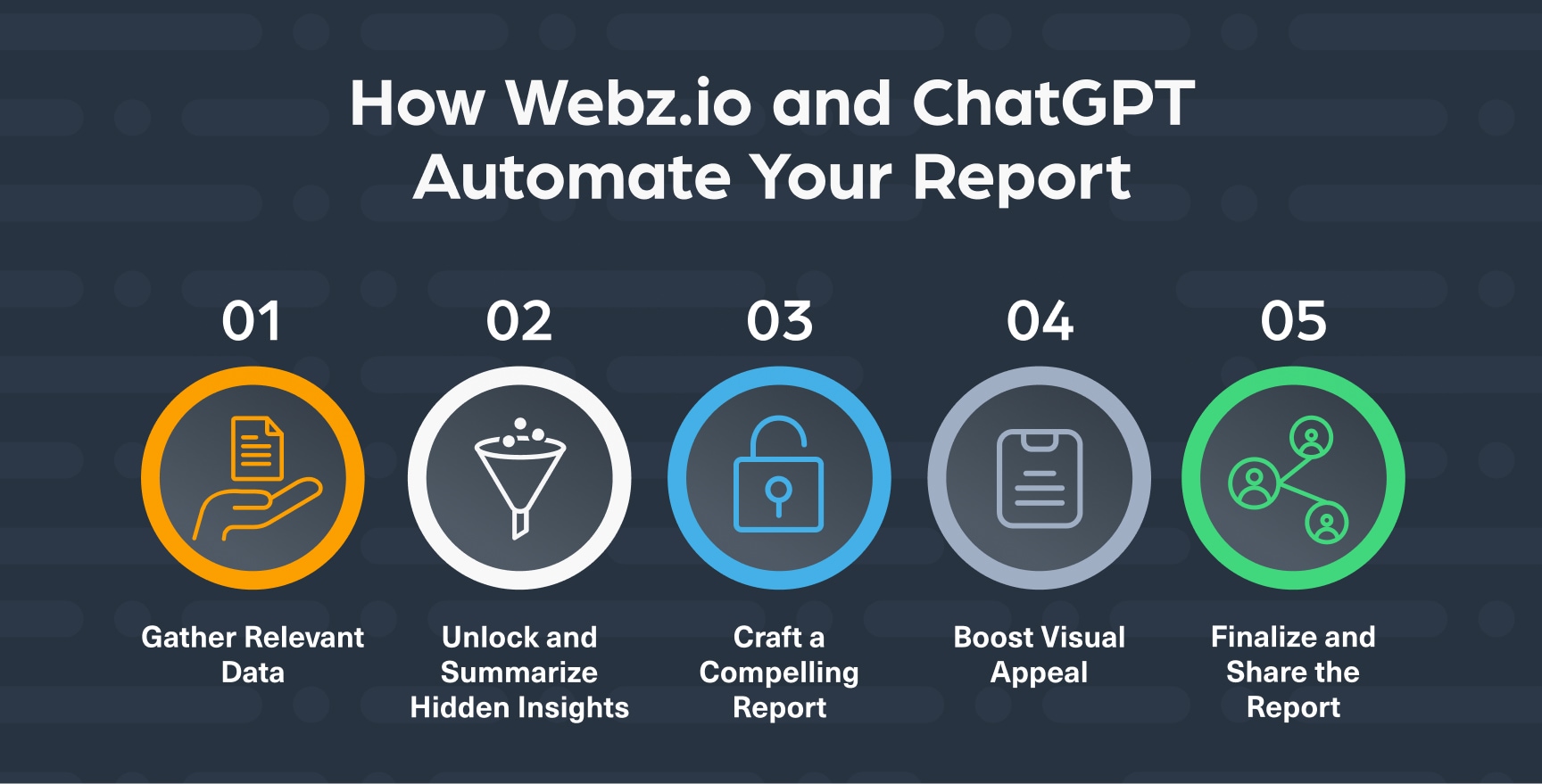How to Automate Financial Risk Reports: A Guide for Developers

If you’re a developer, especially for an automated platform company, this guide is for you. It walks you through a script we created to generate financial risk reports automatically. Creating these reports manually takes a lot of time and energy — something few developers have. However, you can automate the report generation process with AI and some scripting. You can find links to download the script file and related materials at the bottom of this guide.
What you’ll need to run the script
News Data — You should obtain news data from a reliable source. For this guide, we’re getting the data from the Webz.io News API. It provides structured news data feeds in 170+ languages from millions of news sites.
You need an API key to use the Webz.io News API, and you can get one by contacting Webz.io.
- OpenAI API — You’ll use OpenAI’s API to leverage the GPT-4 and DALL·E models. GPT-4 analyzes and summarizes the text from customer reviews, while DALL·E generates a main image for the report.
- You also need an API key for the OpenAI API. Create an account or sign in at OpenAI to get a key. OpenAI uses pay-per-use pricing for its language and image models. You can see the price points on the OpenAI website.
- Python — We’re using Python to automate the report creation process. You’ll need to ensure you can run Python code on your machine.

Automating financial risk reports: script breakdown
The script fetches news articles from the Webz.io News API. Next, the script calls the OpenAI API, using its text model to analyze the articles for content related to financial risk. It then creates a structured report for each article, outputting its findings into a Word document. The script uses the OpenAI image model to generate a main image for the report. The script combines all these elements into a completed report contained in the Word document.
Here is the detailed breakdown of the script:
Import packages and modules
First, the script imports the Python packages and modules, the OpenAI Python API library, and other necessary components.
|
1 2 3 4 5 6 7 8 9 10 11 12 |
import docx import requests from openai import OpenAI import os import openai from Levenshtein import ratio from docx.shared import Pt from bs4 import BeautifulSoup import io from docx.oxml.shared import OxmlElement, qn from docx.shared import Pt from docx.enum.text import WD_ALIGN_PARAGRAPH |
Set global variable and access API keys
Next the script accesses the API keys (Webz.io and OpenAI) through the development environment. It also includes a global variable where you can set the number of articles the script will generate a report on.
|
1 2 3 4 |
WEBZ_API_KEY = os.getenv("WEBZ_API_KEY") openai.api_key = os.getenv("OPENAI_API_KEY") NUM_OF_REPORTS = 5 # Set the number of articles the script will generate a report on. client = OpenAI() |
Orchestrate entire process (main)
Towards the end of the script, you’ll see the “main” function. It orchestrates the entire process — from reading the news articles and generating reports for each one to creating a main report image to finalizing the Word document.
|
1 2 3 4 5 6 7 8 9 10 11 12 |
def main(): image_url = generate_article_image() filtered_articles = get_unique_posts_from_webz("""category:"Economy, Business and Finance" num_chars:>1000 sentiment:negative language:english published:>now-7d social.facebook.likes:>10""") reports = generate_reports(filtered_articles) intro = generate_intro(reports) title_text = generate_title(intro) create_word_doc("financial risk digest.docx", title_text, image_url, intro, reports) if __name__ == "__main__": main() |
Define functions
Now we define the different functions of our script:
Fetch news articles from Webz.io (def fetch_articles)
Makes a call to the Webz.io News API to get articles with content related to financial risk.
|
1 2 3 4 5 6 7 8 9 10 11 12 13 14 15 16 17 18 19 20 21 22 23 24 25 26 27 28 29 |
# Function to get news articles from Webz.io API def fetch_articles(query, api_key, total): endpoint = f"https://api.webz.io/filterWebContent?token={api_key}&format=json&q={query}&size=100&ts=0" all_posts = [] while total > 0: response = requests.get(endpoint) data = response.json() posts = data["posts"] all_posts.extend(posts) total -= len(posts) if total > 0 and "next" in data: endpoint = f"https://api.webz.io{data['next']}" else: break articles = [] for article in all_posts: article = {'title': article["title"], 'text': trim_string(trim_title(article["title"]) + "\n\n" + article["text"], 10000), 'link': article['url'], 'published': article['published']} articles.append(article) return articles |
Remove duplicate posts (get_unique_posts_from_webz)
Removes duplicate posts in case they exist.
|
1 2 3 4 5 |
def get_unique_posts_from_webz(query): print("Fetch posts from Webz.io") articles = fetch_articles(query, WEBZ_API_KEY, 100) filtered_articles = remove_similar_strings(articles) return filtered_articles |
Look for similar strings (are_similar)
Checks if two strings are similar based on the Levenshtein ratio.
|
1 2 3 4 5 |
def are_similar(str1, str2, threshold=1): """ Check if two strings are similar based on Levenshtein ratio. """ return ratio(str1, str2) > threshold |
Remove similar articles (remove_similar_strings)
Eliminates duplicate content by removing articles based on similar strings.
|
1 2 3 4 5 6 |
def remove_similar_strings(articles): unique_articles = [] for article in articles: if not any(are_similar(article['text'], existing['text'], 0.7) for existing in unique_articles): unique_articles.append(article) return unique_articles |
Trim string (trim_string)
Makes sure a string isn’t longer than max_length .
|
1 2 3 4 5 |
def trim_string(string, max_length): if len(string) > max_length: return string[:max_length] else: return string |
Trim article title (trim_title)
Removes irrelevant text from the title. For example, if the real title includes “- CNN News” the script will remove this phrase.
|
1 2 3 4 5 6 7 8 9 10 11 12 13 14 |
def trim_title(input_string): words = input_string.split() if "|" in input_string: return input_string.split("|")[0] last_dash_index = input_string.rfind("-") if last_dash_index != -1: right_of_dash = input_string[last_dash_index + 1:] right_words = right_of_dash.split() if len(right_words) <= 3 and len(words) > 10: return input_string[:last_dash_index] return input_string |
Send prompt (call_gpt_completion)
Sends a prompt to the GPT-4 model and receives a response.
|
1 2 3 4 5 6 7 8 |
def call_gpt_completion(prompt): return client.chat.completions.create( model="gpt-4-1106-preview", max_tokens=4096, messages=[ {"role": "user", "content": prompt}, ] ) |
Review articles and generate reports (generate_reports)
Goes through articles pulled from the Webz.io News API to determine if any contain content related to a specific financial risk. If an article does mention a financial risk, the script generates a report for it.
|
1 2 3 4 5 6 7 8 9 10 11 12 13 14 15 16 17 18 19 20 21 22 23 24 25 26 27 28 29 30 31 32 33 34 35 36 37 38 39 40 41 42 43 44 45 46 47 48 49 50 51 52 53 54 55 56 57 58 59 60 61 62 63 64 65 66 67 68 69 70 71 72 73 74 75 76 77 78 79 80 81 82 83 84 85 86 87 88 89 90 91 92 93 94 95 96 |
def generate_reports(filtered_articles): print("Generating Reports") reports = [] for article in filtered_articles: print(f"Creating report about: {article['title']}") prompt = f"""Carefully review the following negative news article in the 'Economy, Business, and Finance' category and determine if there is an explicit financial risk emerging from its content. The article is as follows: [ {article['text']} ] If the article explicitly mentions or clearly implies a financial risk, generate a detailed financial risk analysis report in HTML format. Use <B> tags to highlight the titles of each section and <UL> and <LI> tags for listing items. The report should include the following sections: <HTML> <B>1. Executive Summary:</B> <UL> <LI>Summarize the main points and the explicit financial risk identified in the article.</LI> </UL> <B>2. Background Information:</B> <UL> <LI>Provide background on the event or issue, focusing on aspects related to the identified financial risk.</LI> </UL> <B>3. Key Data Extracted:</B> <UL> <LI>List key figures, statistics, and significant quotes that are relevant to the financial risk.</LI> </UL> <B>4. Market and Economic Indicators Impacted:</B> <UL> <LI>Discuss the impact on financial markets and economic indicators as it relates to the identified risk.</LI> </UL> <B>5. Industry-Specific Impact:</B> <UL> <LI>Detail the effects on industries, specifically in relation to the financial risk highlighted in the article.</LI> </UL> <B>6. Company-Specific Impact:</B> <UL> <LI>If specific companies are mentioned in the context of the financial risk, explain how the event impacts them.</LI> </UL> <B>7. Regulatory and Compliance Implications:</B> <UL> <LI>Mention any regulatory or compliance issues related to the financial risk.</LI> </UL> <B>8. Risk Assessment:</B> <UL> <LI>Assess the financial risks, focusing on those explicitly mentioned or implied in the article.</LI> </UL> <B>9. Mitigation Strategies and Recommendations:</B> <UL> <LI>Suggest strategies for mitigating the identified financial risks, based on the article.</LI> </UL> <B>10. Conclusion:</B> <UL> <LI>Conclude with the overall implications of the identified financial risk.</LI> </UL> </HTML> If the article does not explicitly mention or imply a financial risk, please respond with: can't produce report. """ try: response = call_gpt_completion(prompt) report = {'text': ''} for choice in response.choices: report['text'] += choice.message.content if "Executive Summary" in report['text']: report['link'] = article['link'] report['title'] = article['title'] report['published'] = article['published'] reports.append(report) print(f"Created a report about: {article['title']}") else: print(f"Can't product report for: {article['title']}") if len(reports) == NUM_OF_REPORTS: break except Exception as e: print("An error occurred:", str(e)) return reports |
Generate title (generate_title)
Creates a title for the financial risk report.
|
1 2 3 4 5 6 7 8 9 10 11 12 13 14 15 16 17 18 |
def generate_title(intro): print("Creating a title") prompt = "Create a title using the following text as a context:\n" + intro title_text = "" try: response = call_gpt_completion(prompt) for choice in response.choices: title_text += choice.message.content except Exception as e: print("An error occurred:", str(e)) title_text = title_text.strip().strip('\"') if title_text.startswith("Title:"): # Sometimes ChatGPT prefix the title with Title: return title_text[len("Title:"):] return title_text |
Generate introduction (generate_intro)
Generates an introductory paragraph for the report.
|
1 2 3 4 5 6 7 8 9 10 11 12 13 14 15 16 17 18 19 20 |
def generate_intro(reports): print("Generate post intro") prompt = """ Write a paragraph introducing a digest that contains financial risk reports about the following titles, don't elaborate on these titles: [] The reports are created automatically by using Webz.io news api and ChatGPT. The reports are generated by calling the Webz.io news API for negative sentiment news articles categorized as "Economy, Business and Finance". The matching news articles are then run through a ChatGPT prompt to analyze if there is a financial risk in the article. If so it create a structured financial risk report. """ prompt = insert_titles_in_text(prompt, reports) intro = "" try: response = call_gpt_completion(prompt) for choice in response.choices: intro += choice.message.content except Exception as e: print("An error occurred:", str(e)) return intro |
HTML to formatted text (html_to_word)
Converts HTML content to formatted text in a Word document. It handles bold text and bullet lists.
|
1 2 3 4 5 6 7 8 9 10 11 |
def html_to_word(doc, html_content): soup = BeautifulSoup(html_content, 'html.parser') for element in soup.find_all(['b', 'ul']): if element.name == 'b': # Add bold text as a heading doc.add_paragraph(element.get_text(), style='Heading 2') elif element.name == 'ul': for item in element.find_all('li'): # Add list items doc.add_paragraph(item.get_text(), style='List Bullet') |
Add hyperlink (add_hyperlink)
Inserts a hyperlink into a Word document paragraph.
|
1 2 3 4 5 6 7 8 9 10 11 12 13 14 15 16 17 18 19 20 21 22 23 24 25 26 27 28 |
def add_hyperlink(paragraph, url, text): """ Add a hyperlink to a paragraph. """ part = paragraph.part r_id = part.relate_to(url, docx.opc.constants.RELATIONSHIP_TYPE.HYPERLINK, is_external=True) hyperlink = OxmlElement('w:hyperlink') hyperlink.set(qn('r:id'), r_id, ) new_run = OxmlElement('w:r') rPr = OxmlElement('w:rPr') u = OxmlElement('w:u') u.set(qn('w:val'), 'single') rPr.append(u) u = OxmlElement('w:u') u.set(qn('w:val'), 'single') rPr.append(u) new_run.append(rPr) new_run.text = text hyperlink.append(new_run) paragraph._p.append(hyperlink) return hyperlink |
Add title placeholder (insert_titles_in_text)
Adds a placeholder for inserting the titles.
|
1 2 3 4 5 6 7 8 9 10 11 |
def insert_titles_in_text(text, reports): # Placeholder for inserting the titles placeholder = "[]" # Extracting the titles from the reports and formatting them with new lines titles = "\n".join([report['title'] for report in reports]) # Replacing the placeholder with the titles updated_text = text.replace(placeholder, titles) return updated_text |
Generate image (generate_article_image)
Generates a main image for the report using OpenAI’s DALL-E model with a specific prompt.
|
1 2 3 4 5 6 7 8 9 10 11 12 13 14 15 16 17 18 |
def generate_article_image(): print("Generating post image") image_url = "" try: response = client.images.generate( model="dall-e-3", prompt="Create a realistic featured image for a financial risk reports. The image should depict a modern office environment with a large, clear display screen in the background showing graphs, random companies logos and financial data. In the foreground, arrange a series of different, but related, documents or tablets, each representing a different financial risk report. These documents should be partially overlapped to convey a sense of abundance and detail. Include elements like pens, glasses, and other office accessories to add to the realism. The overall tone should be professional and sophisticated.", n=1, size="1024x1024" ) image_url = response.data[0].url except Exception as e: print("An error occurred generating the image:", str(e)) return image_url |
Download image (add_image_from_base64)
Downloads an image from a URL and adds it to a Word document.
|
1 2 3 4 5 6 7 8 9 |
def add_image_from_base64(doc, image_url): response = requests.get(image_url) # Check if the request was successful if response.status_code == 200: image_stream = io.BytesIO(response.content) doc.add_picture(image_stream, width=docx.shared.Inches(6)) else: print(f"Failed to download image. Status code: {response.status_code}") |
Create Word doc (create_word_doc)
Assembles the various components into a formatted Word document.
|
1 2 3 4 5 6 7 8 9 10 11 12 13 14 15 16 17 18 19 20 21 22 23 24 25 26 27 28 29 30 31 32 33 34 35 36 37 |
def create_word_doc(file_name, title_text, image_url, intro, reports): print("Saving to word document") doc = docx.Document() # Add a title title = doc.add_paragraph() title.style = 'Title' title_run = title.add_run(title_text) title_run.font.size = Pt(24) # Set the font size title_run.font.name = 'Arial (Body)' # Set the font title.alignment = WD_ALIGN_PARAGRAPH.CENTER # Center align the title if len(image_url) > 0: add_image_from_base64(doc, image_url) doc.add_paragraph(intro) # Add each report for report in reports: p = doc.add_paragraph(style='Heading 1') add_hyperlink(p, report['link'], report['title']) doc.add_paragraph(f"Published on: {report['published']}") html_to_word(doc, report['text']) doc.add_paragraph(""" """) p = doc.add_paragraph("If you're interested in understanding the process behind this report's generation, you have the opportunity to explore it in detail. The complete code used to create this report is openly available for download on GitHub. By visiting the following address: ") add_hyperlink(p, "https://github.com/Webhose/financial-risk-report","https://github.com/Webhose/financial-risk-report") p.add_run(", you can access and review the code, offering you an insightful look into the methodologies and techniques employed in the development of this financial risk report. This transparency allows for a deeper understanding and potential customization to suit specific analytical needs.") for paragraph in doc.paragraphs: for run in paragraph.runs: run.font.name = 'Arial (Body)' # Save the document doc.save(file_name) |
AI + Python = a powerful automation tool
This script demonstrates an advanced use case of integrating AI-powered analysis and content generation with document automation in Python. It’s a comprehensive example of how combining various Python libraries with AI models can produce a powerful automation tool.
Download the example code and report
The full Python script.
|
1 2 3 4 5 6 7 8 9 10 11 12 13 14 15 16 17 18 19 20 21 22 23 24 25 26 27 28 29 30 31 32 33 34 35 36 37 38 39 40 41 42 43 44 45 46 47 48 49 50 51 52 53 54 55 56 57 58 59 60 61 62 63 64 65 66 67 68 69 70 71 72 73 74 75 76 77 78 79 80 81 82 83 84 85 86 87 88 89 90 91 92 93 94 95 96 97 98 99 100 101 102 103 104 105 106 107 108 109 110 111 112 113 114 115 116 117 118 119 120 121 122 123 124 125 126 127 128 129 130 131 132 133 134 135 136 137 138 139 140 141 142 143 144 145 146 147 148 149 150 151 152 153 154 155 156 157 158 159 160 161 162 163 164 165 166 167 168 169 170 171 172 173 174 175 176 177 178 179 180 181 182 183 184 185 186 187 188 189 190 191 192 193 194 195 196 197 198 199 200 201 202 203 204 205 206 207 208 209 210 211 212 213 214 215 216 217 218 219 220 221 222 223 224 225 226 227 228 229 230 231 232 233 234 235 236 237 238 239 240 241 242 243 244 245 246 247 248 249 250 251 252 253 254 255 256 257 258 259 260 261 262 263 264 265 266 267 268 269 270 271 272 273 274 275 276 277 278 279 280 281 282 283 284 285 286 287 288 289 290 291 292 293 294 295 296 297 298 299 300 301 302 303 304 305 306 307 308 309 310 311 312 313 314 315 316 317 318 319 320 321 322 323 324 325 326 327 328 329 330 331 332 333 334 335 336 337 338 339 340 341 342 343 344 345 346 347 348 349 350 351 352 353 354 355 356 357 358 359 360 361 362 363 364 365 366 367 368 369 370 371 372 373 374 375 376 377 378 379 380 381 382 383 384 385 386 387 388 |
import docx import requests from openai import OpenAI import os import openai from Levenshtein import ratio from docx.shared import Pt from bs4 import BeautifulSoup import io from docx.oxml.shared import OxmlElement, qn from docx.shared import Pt from docx.enum.text import WD_ALIGN_PARAGRAPH import json WEBZ_API_KEY = os.getenv("WEBZ_API_KEY") openai.api_key = os.getenv("OPENAI_API_KEY") NUM_OF_REPORTS = 5 client = OpenAI() def are_similar(str1, str2, threshold=1): """ Check if two strings are similar based on Levenshtein ratio. """ return ratio(str1, str2) > threshold def remove_similar_strings(articles): unique_articles = [] for article in articles: if not any(are_similar(article['text'], existing['text'], 0.7) for existing in unique_articles): unique_articles.append(article) return unique_articles def trim_string(string, max_length): if len(string) > max_length: return string[:max_length] else: return string # Function to get news articles from Webz.io API def fetch_articles(query, api_key, total): endpoint = f"https://api.webz.io/filterWebContent?token={api_key}&format=json&q={query}&size=100&ts=0" all_posts = [] # load from local file if you don't have access to webz.io # with open('financial_posts.json', 'r', encoding='utf-8') as file: # all_posts = json.load(file)['posts'] # total = 0 while total > 0: response = requests.get(endpoint) data = response.json() posts = data["posts"] all_posts.extend(posts) total -= len(posts) if total > 0 and "next" in data: endpoint = f"https://api.webz.io{data['next']}" else: break articles = [] for article in all_posts: article = {'title': article["title"], 'text': trim_string(trim_title(article["title"]) + "\n\n" + article["text"], 10000), 'link': article['url'], 'published': article['published']} articles.append(article) return articles def trim_title(input_string): words = input_string.split() if "|" in input_string: return input_string.split("|")[0] last_dash_index = input_string.rfind("-") if last_dash_index != -1: right_of_dash = input_string[last_dash_index + 1:] right_words = right_of_dash.split() if len(right_words) <= 3 and len(words) > 10: return input_string[:last_dash_index] return input_string def add_image_from_base64(doc, image_url): response = requests.get(image_url) # Check if the request was successful if response.status_code == 200: image_stream = io.BytesIO(response.content) doc.add_picture(image_stream, width=docx.shared.Inches(6)) else: print(f"Failed to download image. Status code: {response.status_code}") def html_to_word(doc, html_content): soup = BeautifulSoup(html_content, 'html.parser') for element in soup.find_all(['b', 'ul']): if element.name == 'b': # Add bold text as a heading doc.add_paragraph(element.get_text(), style='Heading 2') elif element.name == 'ul': for item in element.find_all('li'): # Add list items doc.add_paragraph(item.get_text(), style='List Bullet') def add_hyperlink(paragraph, url, text): """ Add a hyperlink to a paragraph. """ part = paragraph.part r_id = part.relate_to(url, docx.opc.constants.RELATIONSHIP_TYPE.HYPERLINK, is_external=True) hyperlink = OxmlElement('w:hyperlink') hyperlink.set(qn('r:id'), r_id,) new_run = OxmlElement('w:r') rPr = OxmlElement('w:rPr') u = OxmlElement('w:u') u.set(qn('w:val'), 'single') rPr.append(u) u = OxmlElement('w:u') u.set(qn('w:val'), 'single') rPr.append(u) new_run.append(rPr) new_run.text = text hyperlink.append(new_run) paragraph._p.append(hyperlink) return hyperlink def insert_titles_in_text(text, reports): # Placeholder for inserting the titles placeholder = "[]" # Extracting the titles from the reports and formatting them with new lines titles = "\n".join([report['title'] for report in reports]) # Replacing the placeholder with the titles updated_text = text.replace(placeholder, titles) return updated_text def generate_article_image(): print("Generating post image") image_url = "" try: response = client.images.generate( model="dall-e-3", prompt="Create a realistic featured image for a financial risk reports. The image should depict a modern office environment with a large, clear display screen in the background showing graphs, random companies logos and financial data. In the foreground, arrange a series of different, but related, documents or tablets, each representing a different financial risk report. These documents should be partially overlapped to convey a sense of abundance and detail. Include elements like pens, glasses, and other office accessories to add to the realism. The overall tone should be professional and sophisticated.", n=1, size="1024x1024" ) image_url = response.data[0].url except Exception as e: print("An error occurred generating the image:", str(e)) return image_url def get_unique_posts_from_webz(query): print("Fetch posts from Webz.io") articles = fetch_articles(query, WEBZ_API_KEY, 100) filtered_articles = remove_similar_strings(articles) return filtered_articles def call_gpt_completion(prompt): return client.chat.completions.create( model="gpt-4-1106-preview", max_tokens=4096, messages=[ {"role": "user", "content": prompt}, ] ) def generate_reports(filtered_articles): print("Generating Reports") reports = [] for article in filtered_articles: print(f"Creating report about: {article['title']}") prompt = f"""Carefully review the following negative news article in the 'Economy, Business, and Finance' category and determine if there is an explicit financial risk emerging from its content. The article is as follows: [ {article['text']} ] If the article explicitly mentions or clearly implies a financial risk, generate a detailed financial risk analysis report in HTML format. Use <B> tags to highlight the titles of each section and <UL> and <LI> tags for listing items. The report should include the following sections: <HTML> <B>1. Executive Summary:</B> <UL> <LI>Summarize the main points and the explicit financial risk identified in the article.</LI> </UL> <B>2. Background Information:</B> <UL> <LI>Provide background on the event or issue, focusing on aspects related to the identified financial risk.</LI> </UL> <B>3. Key Data Extracted:</B> <UL> <LI>List key figures, statistics, and significant quotes that are relevant to the financial risk.</LI> </UL> <B>4. Market and Economic Indicators Impacted:</B> <UL> <LI>Discuss the impact on financial markets and economic indicators as it relates to the identified risk.</LI> </UL> <B>5. Industry-Specific Impact:</B> <UL> <LI>Detail the effects on industries, specifically in relation to the financial risk highlighted in the article.</LI> </UL> <B>6. Company-Specific Impact:</B> <UL> <LI>If specific companies are mentioned in the context of the financial risk, explain how the event impacts them.</LI> </UL> <B>7. Regulatory and Compliance Implications:</B> <UL> <LI>Mention any regulatory or compliance issues related to the financial risk.</LI> </UL> <B>8. Risk Assessment:</B> <UL> <LI>Assess the financial risks, focusing on those explicitly mentioned or implied in the article.</LI> </UL> <B>9. Mitigation Strategies and Recommendations:</B> <UL> <LI>Suggest strategies for mitigating the identified financial risks, based on the article.</LI> </UL> <B>10. Conclusion:</B> <UL> <LI>Conclude with the overall implications of the identified financial risk.</LI> </UL> </HTML> If the article does not explicitly mention or imply a financial risk, please respond with: can't produce report. """ try: response = call_gpt_completion(prompt) report = {'text': ''} for choice in response.choices: report['text'] += choice.message.content if "Executive Summary" in report['text']: report['link'] = article['link'] report['title'] = article['title'] report['published'] = article['published'] reports.append(report) print(f"Created a report about: {article['title']}") else: print(f"Can't product report for: {article['title']}") if len(reports) == NUM_OF_REPORTS: break except Exception as e: print("An error occurred:", str(e)) return reports def generate_intro(reports): print("Generate post intro") prompt = """ Write a paragraph introducing a digest that contains financial risk reports about the following titles, don't elaborate on these titles: [] The reports are created automatically by using Webz.io news api and ChatGPT. The reports are generated by calling the Webz.io news API for negative sentiment news articles categorized as "Economy, Business and Finance". The matching news articles are then run through a ChatGPT prompt to analyze if there is a financial risk in the article. If so it create a structured financial risk report. """ prompt = insert_titles_in_text(prompt, reports) intro = "" try: response = call_gpt_completion(prompt) for choice in response.choices: intro += choice.message.content except Exception as e: print("An error occurred:", str(e)) return intro def generate_title(intro): print("Creating a title") prompt = "Create a title using the following text as a context:\n" + intro title_text = "" try: response = call_gpt_completion(prompt) for choice in response.choices: title_text += choice.message.content except Exception as e: print("An error occurred:", str(e)) title_text = title_text.strip().strip('\"') if title_text.startswith("Title:"): # Sometimes ChatGPT prefix the title with Title: return title_text[len("Title:"):] return title_text def create_word_doc(file_name, title_text, image_url, intro, reports): print("Saving to word document") doc = docx.Document() # Add a title title = doc.add_paragraph() title.style = 'Title' title_run = title.add_run(title_text) title_run.font.size = Pt(24) # Set the font size title_run.font.name = 'Arial (Body)' # Set the font title.alignment = WD_ALIGN_PARAGRAPH.CENTER # Center align the title if len(image_url) > 0: add_image_from_base64(doc, image_url) doc.add_paragraph(intro) # Add each report for report in reports: p = doc.add_paragraph(style='Heading 1') add_hyperlink(p, report['link'], report['title']) doc.add_paragraph(f"Published on: {report['published']}") html_to_word(doc, report['text']) doc.add_paragraph(""" """) p = doc.add_paragraph("If you're interested in understanding the process behind this report's generation, you have the opportunity to explore it in detail. The complete code used to create this report is openly available for download on GitHub. By visiting the following address: ") add_hyperlink(p, "https://github.com/Webhose/financial-risk-report","https://github.com/Webhose/financial-risk-report") p.add_run(", you can access and review the code, offering you an insightful look into the methodologies and techniques employed in the development of this financial risk report. This transparency allows for a deeper understanding and potential customization to suit specific analytical needs.") for paragraph in doc.paragraphs: for run in paragraph.runs: run.font.name = 'Arial (Body)' # Save the document doc.save(file_name) def main(): image_url = generate_article_image() filtered_articles = get_unique_posts_from_webz("""category:"Economy, Business and Finance" num_chars:>1000 sentiment:negative language:english published:>now-7d social.facebook.likes:>10""") reports = generate_reports(filtered_articles) intro = generate_intro(reports) title_text = generate_title(intro) create_word_doc("financial risk digest.docx", title_text, image_url, intro, reports) if __name__ == "__main__": main() |
Download the auto-generated report
Check the example of auto-generated report in PDF format.
To run the script
- Ensure that Python and the required Python libraries are installed on your machine.
- Set your OpenAI API key in your development environment.
- Set your Webz.io News API key in your development environment.
- Run the script.
Ready to automate financial risk insights for your organization faster? Talk to one of our experts today.





